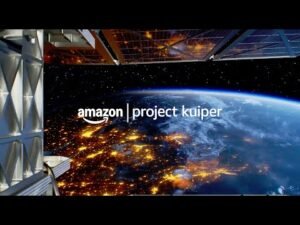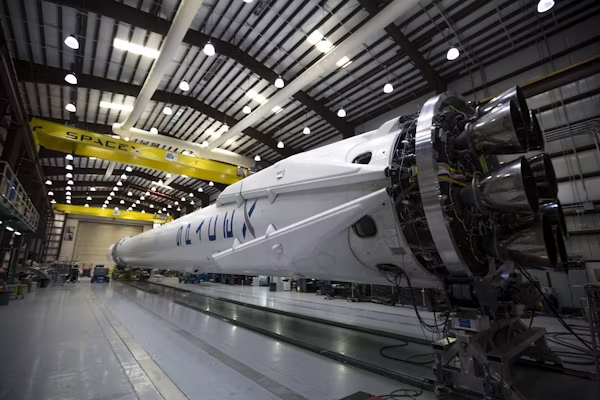Space internet race, starlink vs. project Kuiper. The race to provide global internet from space is intensifying, with two tech giants, SpaceX’s Starlink and Amazon’s Project Kuiper, leading the charge.1 Both aim to connect the world, especially underserved regions, with high-speed, low-latency broadband via massive constellations of Low Earth Orbit (LEO) satellites.2 But who will emerge victorious, and how do their approaches compare?
The Contenders: Starlink’s Head Start vs. Kuiper’s Amazon Advantage
SpaceX’s Starlink has a significant head start in the space internet race.3 As of late May 2025, Starlink has launched over 8,700 satellites, with more than 6,700 currently operational. This rapid deployment began in 2019, allowing Starlink to amass over 5.5 million global subscribers as of April 2025. SpaceX’s reusable Falcon 9 rockets provide a cost-effective and frequent launch capability, a major competitive edge.4
Amazon’s Project Kuiper, while a newer entrant, is backed by the immense resources of Amazon and its founder, Jeff Bezos (who also owns Blue Origin, a rocket company).5 Amazon received FCC approval to deploy 3,236 satellites.6 The first batch of 27 production satellites for Project Kuiper successfully launched on April 28, 2025. Amazon aims to begin offering services to customers in late 2025, with a mandate to launch and operate at least half of its planned satellites by July 2026.
Key Differences: Technology, Cost, and Integration
While both systems rely on LEO satellites for low-latency connectivity, there are notable distinctions:
Satellite Constellation and Altitude
- Starlink: As of late May 2025, Starlink has over 6,700 operational satellites in orbit. These satellites typically operate at an altitude of around 550 km (340 miles).7 SpaceX aims for a total constellation of 12,000 satellites, with a potential extension to 34,400.
- Project Kuiper: Plans for a constellation of 3,236 satellites. The first 27 production satellites launched in April 2025 will ascend to operational altitudes of approximately 630 km (390 miles), with other planned shells at 590 km and 610 km.8 This higher orbit theoretically provides a broader coverage area per satellite.
Launch Strategy and Infrastructure
- Starlink: Leverages SpaceX’s own reusable Falcon 9 rockets, enabling frequent and cost-efficient deployments. This internal launch capability is a major competitive advantage, with Starlink regularly launching dozens of satellites at a time.9
- Project Kuiper: Relies on a diversified launch strategy, contracting with multiple providers including United Launch Alliance (ULA) for Atlas V and Vulcan Centaur rockets, Arianespace for Ariane 6, and Blue Origin for New Glenn. Amazon has also secured three launches on SpaceX’s Falcon 9, showcasing a pragmatic approach to deployment. This multi-provider strategy mitigates launch risk but could complicate logistics.
User Terminals and Pricing
- Starlink: Offers user terminals (dishes) with a hardware cost of around $349-$599.10 Monthly residential plans typically range from $80 to $120.11 Speeds commonly range from 100-250 Mbps.12
- Project Kuiper: Amazon has expressed a strong commitment to affordability.13 They have publicly stated a goal of manufacturing standard terminals for “less than $400” each. They have also developed three terminal options: a compact 7-inch square model (up to 100 Mbps), a standard 11-inch square model (up to 400 Mbps), and a larger enterprise terminal (up to 1 Gbps). While specific monthly pricing is not yet finalized, Amazon’s stated goal is to be highly competitive.
Ecosystem Integration
- Starlink: Primarily focuses on providing direct internet service to consumers and businesses, with specialized plans for maritime, aviation, and mobility.
- Project Kuiper: Aims for deep integration with Amazon’s existing ecosystem, particularly Amazon Web Services (AWS). This could offer unique advantages for enterprise users, IoT applications, and edge computing, leveraging Amazon’s vast cloud infrastructure. This integration could be a significant differentiator, especially for large organizations and specific industry verticals.
The Future of Space Internet: Coexistence or Domination?
While Starlink currently leads in terms of deployed satellites and active subscribers, Project Kuiper’s recent launch of its first production satellites signals a significant intensification of competition in the space internet market.14 Amazon’s substantial investment (over $10 billion), focus on affordability, and potential for deep integration with its existing services could carve out a strong niche.15
Many analysts suggest that the space internet market is large enough for multiple successful players, much like the terrestrial telecommunications industry. The competition between these two tech titans is likely to drive innovation, improve service quality, and potentially lead to more affordable prices for consumers worldwide.
Ultimately, the “domination” of space internet will depend on factors like continued technological advancement, scalability of deployments, pricing strategies, and the ability to attract and retain a diverse customer base. For now, the ongoing race promises a future of increased connectivity for millions globally.
The race to provide global internet from space is intensifying, with two tech giants, SpaceX’s Starlink and Amazon’s Project Kuiper, leading the charge. Both aim to connect the world, especially underserved regions, with high-speed, low-latency broadband via massive constellations of Low Earth Orbit (LEO) satellites. But who will emerge victorious, and how do their approaches compare?
The Contenders: Starlink’s Head Start vs. Kuiper’s Amazon Advantage
SpaceX’s Starlink has a significant head start in the space internet race. As of late May 2025, Starlink has launched over 8,700 satellites, with more than 6,700 currently operational. This rapid deployment began in 2019, allowing Starlink to amass over 5.5 million global subscribers as of April 2025. SpaceX’s reusable Falcon 9 rockets provide a cost-effective and frequent launch capability, a major competitive edge.
Amazon’s Project Kuiper, while a newer entrant, is backed by the immense resources of Amazon and its founder, Jeff Bezos (who also owns Blue Origin, a rocket company). Amazon received FCC approval to deploy 3,236 satellites. The first batch of 27 production satellites for Project Kuiper successfully launched on April 28, 2025. Amazon aims to begin offering services to customers in late 2025, with a mandate to launch and operate at least half of its planned satellites by July 2026. https://scienceandaerospace.blog/space/jeff-bezos-v-elon-musk/
Key Differences: Technology, Cost, and Integration
While both systems rely on LEO satellites for low-latency connectivity, there are notable distinctions:
Satellite Constellation and Altitude
- Starlink: As of late May 2025, Starlink has over 6,700 operational satellites in orbit. These satellites typically operate at an altitude of around 550 km (340 miles). SpaceX aims for a total constellation of 12,000 satellites, with a potential extension to 34,400.
- Project Kuiper: Plans for a constellation of 3,236 satellites. The first 27 production satellites launched in April 2025 will ascend to operational altitudes of approximately 630 km (390 miles), with other planned shells at 590 km and 610 km. This higher orbit theoretically provides a broader coverage area per satellite.

Launch Strategy and Infrastructure
- Starlink: Leverages SpaceX’s own reusable Falcon 9 rockets, enabling frequent and cost-efficient deployments. This internal launch capability is a major competitive advantage, with Starlink regularly launching dozens of satellites at a time.
- Project Kuiper: Relies on a diversified launch strategy, contracting with multiple providers including United Launch Alliance (ULA) for Atlas V and Vulcan Centaur rockets, Arianespace for Ariane 6, and Blue Origin for New Glenn. Amazon has also secured three launches on SpaceX’s Falcon 9, showcasing a pragmatic approach to deployment. This multi-provider strategy mitigates launch risk but could complicate logistics.
User Terminals and Pricing
- Starlink: Offers user terminals (dishes) with a hardware cost of around $349-$599. Monthly residential plans typically range from $80 to $120. Speeds commonly range from 100-250 Mbps.
- Project Kuiper: Amazon has expressed a strong commitment to affordability. They have publicly stated a goal of manufacturing standard terminals for “less than $400” each. They have also developed three terminal options: a compact 7-inch square model (up to 100 Mbps), a standard 11-inch square model (up to 400 Mbps), and a larger enterprise terminal (up to 1 Gbps). While specific monthly pricing is not yet finalized, Amazon’s stated goal is to be highly competitive.
Ecosystem Integration
- Starlink: Primarily focuses on providing direct internet service to consumers and businesses, with specialized plans for maritime, aviation, and mobility.
- Project Kuiper: Aims for deep integration with Amazon’s existing ecosystem, particularly Amazon Web Services (AWS). This could offer unique advantages for enterprise users, IoT applications, and edge computing, leveraging Amazon’s vast cloud infrastructure. This integration could be a significant differentiator, especially for large organizations and specific industry verticals.
The Future of Space Internet: Coexistence or Domination?
While Starlink currently leads in terms of deployed satellites and active subscribers, Project Kuiper’s recent launch of its first production satellites signals a significant intensification of competition in the space internet market. Amazon’s substantial investment (over $10 billion), focus on affordability, and potential for deep integration with its existing services could carve out a strong niche.
Many analysts suggest that the space internet market is large enough for multiple successful players, much like the terrestrial telecommunications industry. The competition between these two tech titans is likely to drive innovation, improve service quality, and potentially lead to more affordable prices for consumers worldwide.
Ultimately, the “domination” of space internet will depend on factors like continued technological advancement, scalability of deployments, pricing strategies, and the ability to attract and retain a diverse customer base. For now, the ongoing race promises a future of increased connectivity for millions globally.
http://Sources: https://www.aboutamazon.com/what-we-do/devices-services/project-kuiper






